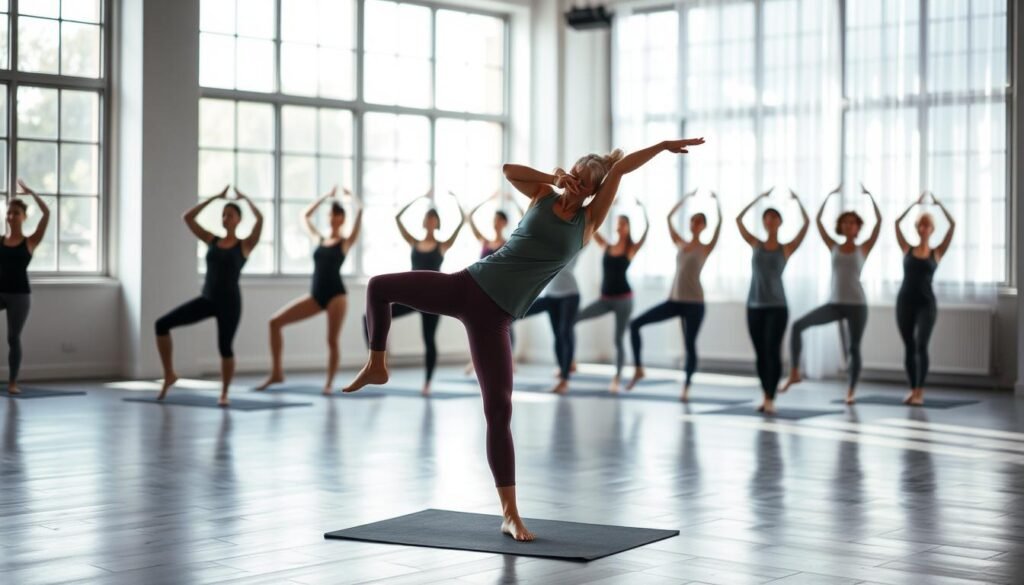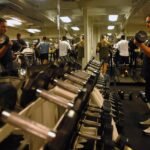Imagine bending down to get your keys and feeling tight in your back. Or reaching for something high and your shoulder hurts. These moments show us our bodies need better movement.
Many don’t see the difference between being flexible and mobile. Flexibility is about stretching muscles. But true freedom in movement is more than that.
It’s about joint health, coordination, and stability together. Without proper movement, our bodies find ways to compensate. This can lead to problems, like awkward squats or hard reaches.
The good news is that Flexibility exercises and movement training can change how we feel and move. It’s not just for athletes. It’s for anyone wanting to move through life with confidence.
Key Takeaways
- True movement freedom combines muscle stretch with joint health and coordination
- Poor range of motion leads to compensatory movements and increased injury risk
- Daily activities become easier when you can move freely through full ranges
- Neuromuscular control improves brain-muscle communication for better balance
- Movement training reduces fall risk and maintains independence as you age
- Everyone benefits from better movement patterns, not just athletes
Why Your Body Desperately Needs Movement Freedom
Every hour you spend sitting or standing is taking away your body’s right to move freely. Your joints weren’t made for the static positions of modern life. Losing mobility in areas like hips, shoulders, and spine harms your whole body.
The good news? Flexibility training benefits do more than just make you feel less stiff. It boosts blood flow, improves muscle control, and increases your range of motion. This helps you move better in all activities.
The Modern Mobility Crisis Affecting Everyone
Your daily life is taking away your natural movement. Desk jobs lead to hip flexion and rounded shoulders. Repetitive tasks cause muscle imbalances that worsen over time.
These issues don’t stay isolated. When your hips can’t move, your lower back compensates. Rounded shoulders affect your neck. Your body finds ways to work around these issues, leading to pain and dysfunction.
Think about it: limited hip mobility affects walking, climbing stairs, and getting out of bed. What starts as minor stiffness can lead to bigger movement problems, affecting your life quality.
Performance Benefits You Simply Cannot Ignore
The flexibility training benefits for performance are impressive. Athletes with better mobility gain more strength and power. Their muscles work more efficiently, leading to better coordination.
Studies show people with higher mobility scores are six times less likely to get injured. This isn’t just for athletes. Better mobility means you can lift groceries, play with kids, and stay active without worrying about getting hurt.
Moving freely improves your performance in all areas of life. Your workouts become more effective, daily tasks feel easier, and you stay independent as you age.
The Critical Difference Between Flexibility and Mobility
Flexibility and mobility are not the same. They are key to unlocking your body’s full ability. Many people mix these terms up, but they are about different parts of movement. Knowing the difference helps you pick the right training and get better results faster.
Your body is like a high-performance car. Flexibility is like the steering range. Mobility is like controlling that steering smoothly at any speed. Both are vital, but they serve different roles in how you move.
Your Passive Range of Motion Foundation
Flexibility is your body’s ability to reach certain positions without using muscles. When you stretch down to touch your toes, you’re showing flexibility. Your muscles relax, letting your joints move through their range.
This passive range is the base for all movement. Without enough flexibility, your joints can’t reach their full range. But, flexibility alone doesn’t mean you can move well or avoid injuries.
Static stretches, yoga, and passive stretches build flexibility. They keep muscles long and joints open. But, they don’t teach your body to control movement through that range.
Active Movement Control That Matters
Mobility goes beyond flexibility by adding strength and control. Joint mobility techniques make your body stable while moving. This active control improves sports and daily life performance.
Mobility exercises train your nervous system for movement. Your muscles learn to work together. This gives you power and stability in different positions.
| Aspect | Flexibility | Mobility |
|---|---|---|
| Movement Type | Passive stretching | Active control |
| Muscle Action | Relaxation and lengthening | Coordinated strength |
| Training Focus | Range achievement | Range control |
| Real-World Application | Foundation building | Functional movement |
Good joint mobility techniques mix both. You need flexibility to get into the range. Then, mobility to control it safely and powerfully.
Flexibility Exercises and Mobility Drills That Change Everything
Your body wants to move freely. These exercises will help you unlock that freedom. They improve how you feel and perform every day. These mobility drills help you overcome common movement limits.
Static stretching and dynamic movements are key. They help you move better. Knowing which exercises work best is important.
Upper Body Flexibility Game-Changers
Modern life hurts your shoulders and thoracic spine. Hours of screen time make your chest tight and shoulders rounded. This limits your reach.
Shoulder pass-throughs with a band or broomstick are great. They open your chest and improve shoulder mobility. Start wide and get closer as you get better.
Thoracic spine rotations fix mid-back stiffness. This causes neck pain and bad posture. These mobility drills help your spine rotate naturally.
- Wall slides for scapular control and overhead positioning
- Doorway chest stretches to open tight pectoral muscles
- Neck side bends and rotations for cervical mobility
- Cross-body shoulder stretches for posterior deltoid flexibility
Lower Body Mobility Powerhouses
Hip mobility affects your squat and walk. Most adults have tight hip flexors and limited hip extension. This leads to lower back problems.
The world’s greatest stretch is a game-changer. It stretches your hip flexors, rotates your thoracic spine, and loosens your hamstrings. It’s very efficient.
Hip circles and leg swings prepare your joints. They improve your range of motion. These movements also boost blood flow and muscle activation.
- 90/90 hip stretches for internal and external rotation
- Couch stretch for deep hip flexor release
- Pigeon pose variations for hip opener flexibility
- Calf stretches against the wall for ankle mobility
Core and Spine Freedom Builders
Your spine needs to move in all directions. Modern life often keeps you in one position. This causes stiffness and dysfunction.
Cat-cow movements restore your spine’s natural movement. This simple exercise helps decompress your spine and improve mobility after sitting.
Thoracic extensions open up your mid-back. Spinal rotations keep your spine twisting. This is important for sports and daily activities.
Movement is a medicine for creating change in a person’s physical, emotional, and mental states.
- Bird dog exercises for core stability and spinal control
- Supine spinal twists for rotational mobility
- Bridge variations for hip extension and spinal extension
- Dead bug patterns for deep core activation
Dynamic Movement Patterns That Unlock Your Potential
Dynamic movement patterns change how your body reacts to physical challenges. They are different from static holds because they move and prepare your muscles and joints. Dynamic stretching wakes up your nervous system and gets blood to your muscles.
The right warm-up can make a big difference in your workout. Your body needs certain signals to switch from resting to performing.
Pre-Workout Activation Sequences That Work
Your pre-workout routine should be quick but effective. Start with gentle movements that get more intense and move more.
Start with arm circles and leg swings to wake up your major joints. Move to walking lunges with a twist to work your core and hips. Add high knees and butt kicks to get your heart rate up.
Dynamic stretching gets your body ready for what’s coming. These movements should be similar to what you’ll do but less intense.
Sport-Specific Movement Preparation
Every sport needs its own warm-up. Runners should do leg swings and walking lunges. Weightlifters need shoulder rolls and hip circles.
Tennis players should do rotational movements and lateral shuffles. Swimmers need arm swings and torso twists for their shoulders and core.
Your warm-up should match your sport’s main movements. This targeted approach with dynamic stretching gets your body ready for your sport.
Daily Mobility Maintenance You’ll Actually Do
Small movement breaks throughout the day fight the bad effects of sitting too long. These “movement snacks” only take 2-3 minutes but offer big benefits.
Try desk-friendly moves like seated spinal twists and shoulder blade squeezes. Stand up for calf raises and gentle neck rolls every hour.
Evening routines can include simple dynamic stretching while watching TV. Leg swings during commercial breaks or arm circles help keep your mobility.
The key is to be consistent, not intense. Small, frequent movements throughout your day keep your joints loose and muscles active. This prevents stiffness and keeps your range of motion.
Stretching Routines That Deliver Real Results
Your body needs different movements all day. Stretching routines provide what it needs. They help your muscles and improve blood flow. It’s important to match your stretches to your body’s needs at different times.
Morning Movement Sequences for Energy
Begin your day with gentle stretches. They wake you up without needing to change clothes or lie down. Gentle spinal twists and hip circles boost blood flow. Shoulder rolls help release tension.
These morning stretching routines only take five minutes but give you energy all day. Move smoothly and control your stretches. This improves your circulation and makes you feel more awake.
Post-Workout Recovery Stretches That Matter
After working out, your muscles need special care. Use static holds for 30-60 seconds on the muscles you used. This helps remove waste and reduces soreness.
Good post-workout stretching routines target the muscles you used most. Foam rolling and gentle movements are great additions. Consistently doing these stretches after workouts helps you recover faster.
Evening Flexibility Sessions for Better Sleep
End your day with calming stretches. They help you relax and prepare for sleep. Use slow, deep breaths while stretching.
Evening stretches should be calming, not intense. Gentle forward folds and supported stretches relax your nervous system. This improves your sleep and helps your muscles recover.
Advanced Joint Mobility Techniques for Peak Function
Professional-grade mobility techniques can change stiff joints into smooth, pain-free movement. These methods are more than simple stretches. They tackle the main reasons for joint stiffness and movement problems.
These advanced techniques mix physical therapy, movement science, and yoga for flexibility training. They focus on joint mechanics, not just muscle length. This focused approach leads to lasting changes in how your body moves and feels.
Targeted Joint Mobilization Methods
Controlled articular rotations are key in targeted joint work. These slow, precise movements help fix joint mechanics in trouble spots. Focus on ankles, thoracic spine, and hips, where issues often arise.
Joint distraction techniques open up tight joints. Use gentle traction while moving through different ranges of motion. This method is great for shoulder and hip issues.
Targeted pressure techniques tackle specific adhesions and trigger points. Use your body weight or tools to apply steady pressure while moving the joint. This approach breaks up stubborn restrictions that passive stretching can’t fix.
Progressive Range Development Strategies
End-range loading builds strength at your movement limits. Hold tough positions while adding light resistance or isometric contractions. This ensures your new range of motion is strong and lasting.
Contract-relax methods use muscle activation to deepen stretches. Tense the target muscle for five seconds, then relax and stretch deeper. This neurological approach, borrowed from yoga for flexibility practices, leads to quick improvements.
Breathing-assisted mobilization uses your breath to help reach deeper ranges. Inhale to create space, exhale to stretch deeper. This technique turns your breath into a powerful mobility tool that works with your nervous system.
Essential Tools and Technology for Modern Mobility
The right mobility tools and equipment can change your flexibility practice. It moves from simple stretching to a full movement system. These tools help you progress faster and enjoy your daily mobility work more.
Quality tools connect your home practice to professional therapy sessions. They help you focus on specific problem areas. This keeps your routine consistent.
Foam Rollers and Self-Massage Equipment
Foam rolling applies pressure to tight muscles and fascial restrictions. Start with a medium-density roller and then move to firmer ones.
Focus on areas like the calves, hamstrings, and thoracic spine for full-body mobility. Spend 30-60 seconds on each spot, rolling slowly and pausing on tender areas.
Massage balls and percussion devices offer deeper, more precise treatment. They reach areas foam rollers can’t, like the feet, shoulders, and neck.
Resistance Bands and Mobility Accessories
Resistance bands offer assisted stretching and muscle strengthening. Loop bands are great for hip activation, while longer bands help with hamstring and shoulder stretches.
Yoga blocks and straps improve your stretch positioning. They help you maintain proper form while safely increasing your range of motion.
Digital Apps and Movement Tracking Tools
Movement apps provide structured routines and track your progress. They offer personalized programs based on your needs and schedule.
Wearable devices monitor your daily movement and remind you to take mobility breaks. This technology keeps you consistent in your practice.
| Tool Category | Primary Benefit | Best For | Price Range |
|---|---|---|---|
| Foam Rollers | Muscle tension release | Large muscle groups | $15-60 |
| Resistance Bands | Assisted stretching | Targeted flexibility | $10-40 |
| Massage Balls | Precise trigger points | Feet and small areas | $8-25 |
| Mobile Apps | Guided routines | Structure and tracking | Free-$15/month |
Creating Your Personal Flexibility Training System
Your journey to better mobility starts with a system tailored to your life. Random stretching won’t give you the steady results you seek. You need a systematic approach that grows over time.
Practicing mobility often leads to better results. You can stretch every day if you like—it’s safe. Beginners should start with 2 to 3 sessions a week. Gradually increase to 4 times a week. Consistency beats intensity every time.
Honest Assessment and Realistic Goal Setting
Before starting any program, know your current mobility level. Evaluate your range of motion in key areas like shoulders, hips, and ankles.
Set SMART goals to stay motivated without getting frustrated. Instead of “I want to be more flexible,” aim for “I want to touch my toes without knee bend in 8 weeks.” Specific targets help you focus.
Smart Program Design for Busy Lives
Your flexibility program must fit your schedule. Whether you have 5 minutes or 45, you can create effective sessions.
Plan different session lengths for various days. Have a quick 10-minute morning routine for weekdays. Use longer 30-minute sessions for weekends. This keeps you consistent, even when life is busy.
| Session Length | Best Time | Focus Areas | Frequency |
|---|---|---|---|
| 5-10 minutes | Morning | Dynamic warm-up | Daily |
| 15-20 minutes | Post-workout | Recovery stretches | 3-4 times/week |
| 30-45 minutes | Evening | Deep flexibility work | 2-3 times/week |
Progress Tracking and Program Evolution
Keep track of your progress with simple methods. Take photos of your range of motion monthly. Record stretch feelings on a 1-10 scale. Note which exercises feel best.
Your program should change as you improve. When exercises get easy, move to harder versions. Continuous adaptation helps you avoid plateaus.
Transform Your Movement and Unlock Your Body’s Full Potential
Your journey toward better movement starts with a single step. Mobility training is key for everything your body does. This includes daily activities and peak athletic performance. You don’t need hours each day to see real changes.
Just five to ten minutes of focused movement work can reshape how you feel and function. Your body craves this attention. When you prioritize mobility, you’re investing in decades of pain-free living ahead.
Injury prevention stretches become second nature when you build consistent habits. Your muscles, joints, and connective tissues respond quickly to regular care. Each day you practice, you’re building resilience against future problems.
Start where you are right now. Pick three exercises from this guide that feel most relevant to your needs. Practice them tomorrow morning. Your future self will appreciate every minute you invest today.
Age doesn’t have to mean stiffness or limitation. You control how your body ages through the choices you make daily. Movement is medicine, and you hold the prescription.
Your body has incredible potentials waiting to be unlocked. Every expert started as a beginner. Every transformation began with someone deciding to prioritize their mobility. Today can be your starting point for a lifetime of better movement, reduced pain, and enhanced performance.
Take action now. Your body is ready when you are.





